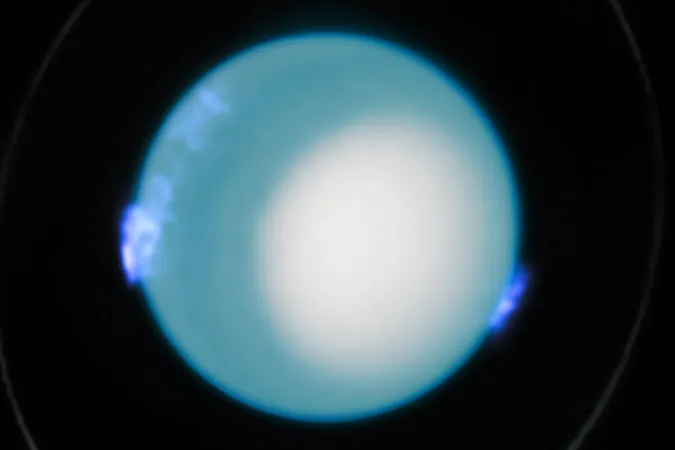
Groundbreaking Discovery Rewrites Our Understanding of Uranus' Rotation!
2025-04-08
Author: Kai
Introduction
In a remarkable turn of events that could reshape our comprehension of Uranus, astronomers utilizing decades-worth of Hubble Space Telescope data have uncovered new insights into the mysterious seventh planet of our solar system. This analysis, recently published in *Nature Astronomy*, has delivered an incredibly precise calculation of Uranus's rotation period—a feat that could redefine how we study this enigmatic planet.
Historical Context
Since its only encounter with a spacecraft during NASA's Voyager 2 flyby on January 24, 1986, there has been limited insight into Uranus. The Voyager mission provided a wealth of information, highlighting peculiarities such as a highly tilted and offset magnetic field. Based on these initial measurements, scientists estimated Uranus's rotation period to be approximately 17 hours, 14 minutes, and 24 seconds, but acknowledged a significant uncertainty with a margin of error of 36 seconds.
Challenges in Observation
Though it might seem trivial, this margin prevented researchers from tracking Uranus's magnetic axis effectively, and attempts to revisit the analysis using data collected during the flyby in 2009 bore no fruit. The challenge lies in Uranus's immense gaseous atmosphere, which obscures direct observation and complicates scientific endeavors.
Breakthrough With Hubble Data
In a breakthrough, astronomers turned to the Hubble Space Telescope, which has been capturing ultraviolet images of Uranus's auroras since 2011. These spectacular light displays, akin to Earth's auroras, are the result of particles from the solar wind colliding with Uranus's magnetic field. Over the years, multiple observations under varying solar conditions have enriched the dataset available for analysis.
Refined Measurements
By combining these Hubble observations with Voyager 2 data, the researchers refined Uranus's rotational speed to an astonishing 17 hours, 14 minutes, and 52 seconds—within the original margin of error yet impressively down to just 0.036 seconds of uncertainty. This revision is monumental, as Laurent Lamy from France's Observatoire de Paris-PSL emphasized, it resolves long-standing discrepancies and provides a crucial reference for planetary scientists worldwide.
Implications for Future Research
This discovery enables past auroral observations, spanning nearly four decades, to be compared and opens up avenues for future expeditions to Uranus. Significantly, this paves the way for an anticipated mission, which although still awaiting a launch schedule, has been earmarked as a priority by NASA since 2022. This upcoming probe aims to intricately map the gravitational and magnetic fields of Uranus, a mission more feasible now that researchers have an accurate rotation period.
Challenges Ahead
However, there is a catch; the mission remains speculative amid budgetary uncertainties within NASA and the broader federal landscape. The question looms: when—or if—humanity will revisit Uranus and delve deeper into its mysteries once again?
Conclusion
As we stand at the brink of potential exploration and discovery, this pivotal moment in our understanding of Uranus serves as a reminder of the vast complexities of our solar system waiting to be uncovered. Stay tuned, as the excitement surrounding Uranus continues to build—what other secrets might this distant planet be hiding?

 Brasil (PT)
Brasil (PT)
 Canada (EN)
Canada (EN)
 Chile (ES)
Chile (ES)
 Česko (CS)
Česko (CS)
 대한민국 (KO)
대한민국 (KO)
 España (ES)
España (ES)
 France (FR)
France (FR)
 Hong Kong (EN)
Hong Kong (EN)
 Italia (IT)
Italia (IT)
 日本 (JA)
日本 (JA)
 Magyarország (HU)
Magyarország (HU)
 Norge (NO)
Norge (NO)
 Polska (PL)
Polska (PL)
 Schweiz (DE)
Schweiz (DE)
 Singapore (EN)
Singapore (EN)
 Sverige (SV)
Sverige (SV)
 Suomi (FI)
Suomi (FI)
 Türkiye (TR)
Türkiye (TR)
 الإمارات العربية المتحدة (AR)
الإمارات العربية المتحدة (AR)